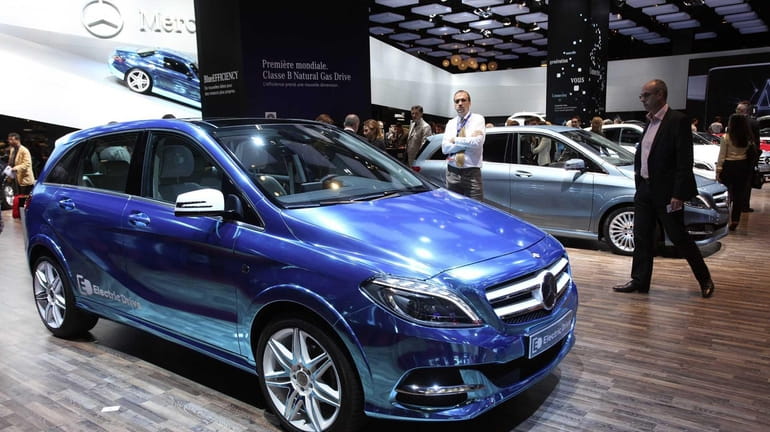How to shop for cars at the New York Auto Show

Paris Motor Show attendees view the Mercedes-Benz B Class Electric Drive (ED) automobile. (Sept. 28, 2012) Credit: Bloomberg News
While still important, test drives aren't the only way car shoppers can narrow down a big list of potential new cars. Auto shows are an invaluable resource for car shoppers to compare an entire segment of vehicles under one roof without the pressure of having to sign papers. Following a few simple tips can narrow down which dealerships to visit for a test drive. Here's our guide.
From the Front Seat
Legroom and headroom specifications don't always add up to usable space in real life. Sitting in the front seat is the only way to know how comfortably and safely you'll fit in a car. Most auto show cars have accessory power to adjust seating and basic controls, so get comfortable and adjust the seat and steering wheel as if you were about to put the car in gear and drive away.
Check for a telescoping steering wheel to maximize finding a comfortable and safe seating position from the frontal air bag. The Insurance Institute for Highway Safety recommends at least 10 inches of distance between a driver and the steering wheel.
Make sure controls for the stereo, heating and air conditioning are easily reachable. Look over both shoulders to gauge visibility.
Those shopping for a car with multiple drivers should make sure all drivers can sit comfortably. Look for optional memory seats that save multiple seating configurations and are identifiable as buttons with "1" and "2" on the door.
From the Rear Seat
After adjusting the front seat to your liking, quickly head to the back before someone gets in and fusses with the driver's seat. Front seating position affects rear legroom, so see how much legroom remains when the driver's seat is positioned where the primary driver sits.
Gauge accessibility of the rear seats of sedans and second and third rows in SUVs and minivans, plus how wide the rear doors open for loading cargo.
In SUVs, see if the backseat slides and reclines for additional legroom and comfort. Look for an intrusive floor hump in the rear from all-wheel drive or the exhaust. Cars without that hump give rear passengers more side to side leg room.
Cargo Area
A cargo floor that's too high off the ground makes loading heavy objects more difficult. Stand next to the car and see how tall the highest point of the cargo opening stands to your body -- knee high, thigh high, waist high? Some cars have a low floor but require lifting up and over a tall opening first.
Make sure the tailgate of an SUV or minivan is within reach when fully open. Some are also power opening and adjustable to different heights to clear a low garage door.
Check out the trunk opening's width on sedans. The trunk's cargo specifications are useless if there's not an opening wide enough to put something substantial inside. Look for outboard trunk hinges that don't intrude into the trunk. Some sedan trunk hinges intrude into the trunk, mashing groceries.
Are there folding rear seats? See how easily they fold and lift up as well as if the seat's release is inside the car or in the trunk.
Kids
Chances are if you have kids then they're coming with you to the auto show. Kids who don't need a child safety seat should see how easily they get into the back seat and buckle themselves into the car, and also how comfortably the seatbelt stretches across their body.
Since car seats can't come along for a test fitting, look for visible Latch anchors, which are easiest to use if they are clearly visible.
If you brought a massive stroller to the show, fold it and throw it in the trunk or cargo area to check fitment and ease of loading.
Third-row access could prove difficult for kids because each automaker has its own way of folding seats with straps, levers and multiple stages; some are easier than others.
